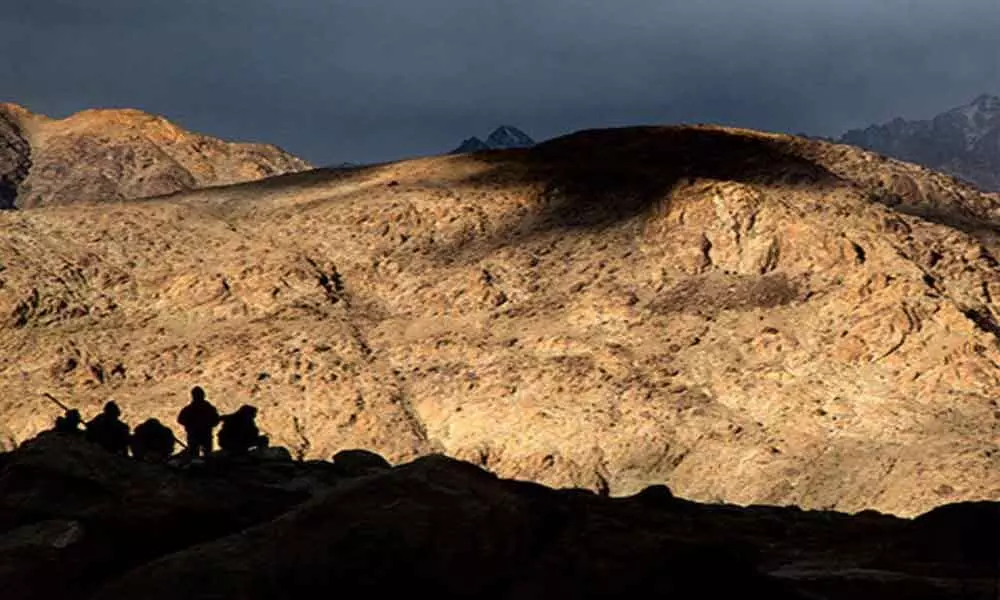India, China disengagement at Ladakh: An unfinished agenda

India, China disengagement at Ladakh: An unfinished agenda
The 11th round of India China Corps Commander's meeting has ended with good optics and pleasantly worded PIB release, with no concrete agreement (if any) disseminated so far.
Post disengagement of troops in Eastern Ladakh from North and South of Pangong Tso, no disengagement in other areas to include Depsang plains, Gogra, Hot Spring, Demchok, and no further de-escalation, was well predicted by most analysts.
In "Two Session" press conference last month, Wang Yi suggested China and India to strengthen cooperation instead of harbouring suspicion at each other and earlier indicated to get back to business as usual, sidelining border/LAC issue.
The Indian Foreign Ministry seems to be conveying that disengagement at all friction points leading to de-escalation, peace and tranquillity on borders are prerequisites to progressing smooth bilateral ties.
This rightful Indian stance is adversely affected by indicators like likelihood of Indian permission to progress 45 Chinese projects and 300 Crore contracts to Huawei, which is not in sync with the stance conveyed.
The standoff is therefore yet to be resolved, as Indian Army Chief general Naravane puts it "the threat has only abated and it has not gone away altogether", although domestic events in both countries have dimmed the spotlight on borders.
Chinese political aim was and continues to be China centric Asia and forcing Indian subordination, a necessity to achieve it.
This aim could not be achieved despite prolonged standoff in Ladakh so far, but will remain unchanged, even in future.
Chinese strategic aim to control Eastern Ladakh was to provide depth to its National Highway G-219, Karakoram Pass and China-Pakistan Economic Corridor (CPEC), redraw Line of Actual Control (LAC) as per its perception and negotiate border on its terms thereafter.
China can claim to have partially achieved it, with continued presence in extra kilometrage in Depsang plains, Gogra, Hot Spring, Demchok areas, where disengagement is yet to take place.
The Indian aim has been to get Chinese back to pre-standoff positions as of April 2020 in all friction points, not to concede unilateral change of LAC, and pursue talks towards its demarcation, hoping to lead to border resolution.
With current disengagement, status quo stands achieved in areas north and south of Pangong Tso, at the cost of losing the crucial leverage of giving up occupation of certain heights on Kailash range and north of Pangong Tso, prior to Chinese vacation of 'Other Areas'. Pursuing disengagement and de-escalation in remaining areas will be an uphill task due to shortage of leverages, given Chinese past track record of junking agreements at will.
China, having marched in areas, where it was not supposed to be, junking all CBMs, as part of overall 'Incremental Encroachment Strategy', exploiting first mover advantage, making unfair use of Indian engagement in combating COVID-19 pandemic.
China soon found itself handicapped by strong Indian response, resistance and resolve, with proactive actions resulting newly created vulnerabilities to Maldo Garrison and its launch pad, South of Pangong Tso.
Despite disengagement in Pangong Tso area, Chinese discomfort due to Indian dispositions in Sub Sector North including DBO, infrastructure development including DSDBO road, as a threat to crucial Tibet-Xinjiang-Pakistan connectivity remains.
Despite proactive tactical, operational and daring actions by Indian military, its strategy was reactive.
Both countries justify disengagement process favourable to them, so far, although disengagement is yet to be done at many friction points.
The Chinese narrative to its population up to "Two Session" has been that it has got Indians down from heights north and south of Pangong Tso and ensured no Indian presence from Finger 4 to Finger 8, no patrolling by declaring it as buffer zone, while retaining its presence in Depsang plains, Gogra, Hot Spring and Demchok areas.
It can, therefore, claim to have launched a successful incremental encroachment operation and edged forward 1959/60 claim line in 'other areas'.
The explainers of Chinese narrative will find it difficult to explain their gain by moving forward from Finger 8 to Finger 4 and then speedily withdrawing back to the same location, indicating weakness of PLA to endure winters in high altitude area, besides making Maldo Garrison vulnerable and risking war, had Indians not obliged by pulling back from heights in Pangong Tso area.
The Indian narrative to its critiques is that it has been able to successfully push Chinese back to status quo ante positions as existed pre standoff in Pangong Tso area, the stance which India maintained throughout.
Amongst rest areas, like Gogra, Hot Spring and Demchok, its work in progress to disengage and restore patrolling rights. Depsang is a legacy issue of decades, where patrolling points to limit ITBP/ Army patrols were designated to avoid confrontation.
Willy-nilly, nearly two-thirds of Depsang Plateau remained outside the purview of physical domination by us, which allowed PLA to establish intensive infrastructure and habitat in the area.
Depsang will therefore, require separate discussion. India can also draw solace from the fact that, while it is being denied patrolling to the patrol points on Depsang Plateau East of the area Bottleneck inside the Raki Nallah, it has also denied PLA patrols movement West of Bottleneck, to Chinese claimed area close to Burtse.
The explainers of Indian narrative will continue to find it difficult to explain why disengagement was not sequenced on 'first in and first out basis', meaning thereby that India should have vacated Kailash Range heights only after China had vacated the areas, where it advanced in Depsang plains, Gogra, Hot Spring and Demchok areas, since April 2020.
It is reasonable to believe that negotiators at all levels must have tried their best and may have had their compulsions, but If Chinese do not act on remaining part of the agreement, it will leave India at a disadvantage, due to shortage of worthwhile leverages.
Notwithstanding the political debates over legacy of Depsang issue, it remains strategically important and a threat to DBO and DS-DBO Road; hence a concern for military professionals.
Indian aim should be not to concede Chinese attempt to redraw LAC as LAC-2020. In light of no major breakthrough in 22nd round of China-India border talks, I do not expect any worthwhile development on delineation, delimitation for demarcation of LAC, which, is necessary to prevent repeated standoffs, even if the present one sees some resolution.
This is inescapable and must be insisted. A temporary solution/side-lining main issue is recipe for the next standoff, leading to LOC-ization of LAC further.
Chinese will like to keep border unsettled, till the time the political cost of Not settling it, becomes higher than doing so, for CCP, China.
Its efforts of bilateral border talks with Bhutan and Nepal including trijunctions, are to create further complications in the long-term resolution of borders.
India must be prepared for 'Two Front War' as a worst case scenario, and continue capacity building in all domains, including maritime arena.
Ongoing infrastructure development along borders should lead to settling of locals in villages along LAC with better facilities, to ward off Chinese design of developing hundreds of new villages along LAC.
Strategic partnerships with like-minded democracies and collective naval posturing to create multifront situation for China are efforts in right direction.
There is a need for alternative supply chain, trade and technological ecosystem, independent of China for which some initial steps taken by Quad countries need to be pursued on strategic plane.
(The writer is a strategic and security analyst, a veteran Infantry General. He is the Chief Instructor, United Service Institution of India. The views expressed are personal)

















